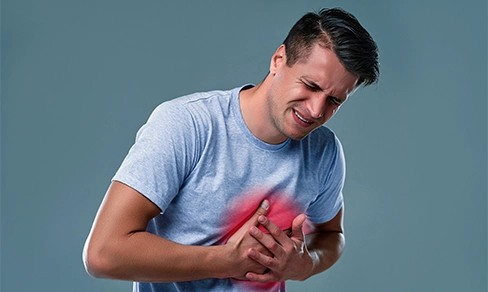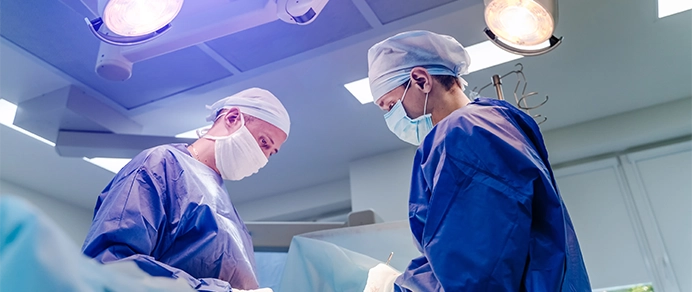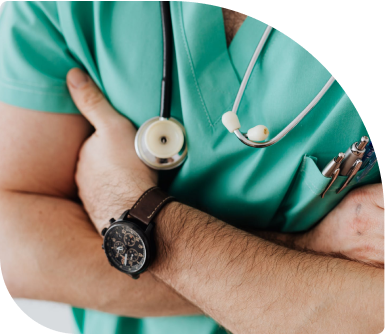— Procedures
Cardioversion
Cardioversion is a procedure for restoring normal rhythm to a heart that is beating usually too quickly or irregularly.
Cardioversion Explained
Cardioversion is a procedure for restoring normal rhythm to a heart that is beating usually too quickly or irregularly. Performed under general anaesthetic, or with a heavy sedative, it uses a controlled burst of electrical energy to return the heart to its natural (‘sinus’) rhythm.


What is cardioversion?
Cardioversion is a fast, effective treatment that aims to restore a hearts regular rhythm by applying a carefully controlled electrical shock to the chest. Electrode patches are placed on your chest and connected to a defibrillator machine, which delivers a short electrical current to the heart. A single shock is often enough to ‘reset’ the heart and return it to a normal rhythm. The improvement in symptoms may happen immediately.
Why would I need to have the procedure?
The rhythm in our hearts is controlled by electrical signals running from the brain to the upper chambers of the heart (the atria). If those signals become disrupted, they can cause the heart to begin pumping at a different pace or with a different rhythm. Two major types of rhythm problems are atrial fibrillation and, less commonly, atrial flutter. These conditions can cause a range of unpleasant symptoms, such as breathlessness, fatigue and dizziness, and can raise the risk of a stroke. If you’ve been diagnosed with either condition, or if you’ve tried certain rhythm medications and they haven’t worked, we may recommend you for the cardioversion procedure.
How does cardioversion actually work?
Cardioversion targets the cells of the heart, called myocytes. The ‘sinus node’, is the heart’s natural pacemaker. In a heart that’s experiencing rhythm problems, the electrical signals become disrupted and chaotic. By delivering a short, sharp current of electricity to the chest (usually around 100-360 joules, in the first instance), we can often ‘jolt’ the heart out of its abnormal rhythm so that its regular, controlled rhythm returns. Cardioversion is considered to be a very safe procedure; complications are rare and most side effects tend to be temporary (see below). Although the treatment is effective for most people, it doesn’t always work for everyone. In around 20% of patients, the abnormal rhythm returns after several days, weeks or months. In these cases we might look to repeat the cardioversion, or consider another kind of treatment.
What will happen during my procedure?
When you arrive at the clinic, we’ll give you a check-up. The nurse will take your blood pressure, pulse and temperature. We’ll also run an electrocardiogram (ECG) test to confirm your heart is still in its abnormal rhythm. You’ll then remove your upper clothing and lie back in a raised position or flat, with your head resting on a pillow, while we place the sticky electrode pads on your chest. If you have chest hair, we may need to shave it at this point if you haven’t done so already. The anaesthetist will then deliver a short-term general anaesthetic to send you to sleep, or a powerful sedative so you’re not troubled by the procedure. This is administered through a cannula in your hand. We then deliver the shock, timed to coincide with a heartbeat. A single shock is usually sufficient, but it’s sometimes necessary to perform a second or third cardioversion with a stronger shock or different electrode positions. The entire procedure can take up to 30 minutes, but is usually completed in around 5-10 mins.
How do I prepare for my treatment?
The main preparation you’ll need to undertake before your cardioversion is a course of anticoagulants (blood thinners). This is because arrhythmia problems like atrial fibrillation can sometimes cause blood clots to form in the heart; although the risk is small, cardioversion could result in the clot breaking off and causing a stroke. To mitigate that risk, we’ll prescribe a very specific course of anticoagulants. You will usually start to take these around four weeks before the procedure and it’s very important that you don’t miss any of the doses. On the day of your cardioversion, you’ll need to fast for six hours before the procedure and avoid fluids two hours beforehand.
What happens after my cardioversion?
The anaesthetic is short-acting, so you’ll wake up soon after the procedure has finished. Once you’re awake, we’ll talk you through the procedure and explain how it went. After an hour or so, the team will repeat the ECG to confirm that your rhythm has gone back to normal. Most patients are able to go home after a few hours. Bear in mind that, due to the general anaesthetic, you won’t be able to drive for at least 24 hours after your cardioversion, so please arrange for a friend or family member to collect you from the clinic afterwards. You may find that your rhythm-problem symptoms improve immediately after the procedure (although the anaesthetic may make you feel groggy or temporarily nauseous). Cardioversions can cause temporary side effects in some patients. These include bradycardia (a slow heart rhythm), ventricular tachycardia (fast rhythm), headaches or dizziness after a drop in blood pressure, and sometimes a slight discomfort around the chest from the electric shock. These usually tend to wear off quickly, however, or are easy to treat. In most cases, you’ll need to continue taking your anticoagulant medication for at least four weeks following the cardioversion. You’ll have a routine follow-up assessment around 6-8 weeks after treatment so that we can check everything is going well.
Patient’s thoughts

Jonathan’s Expertise
Common Questions
Book a Consultation
Reach out and book a consultation with Jonathan.
Expert TREATment
Heart Conditions
Experience expert treatment for heart conditions, with personalised care and advanced technology with Jonathan Lyne Heart Rhythm Cardiologist.
Extra heartbeats, usually harmless, occasionally need further investigation for caution.